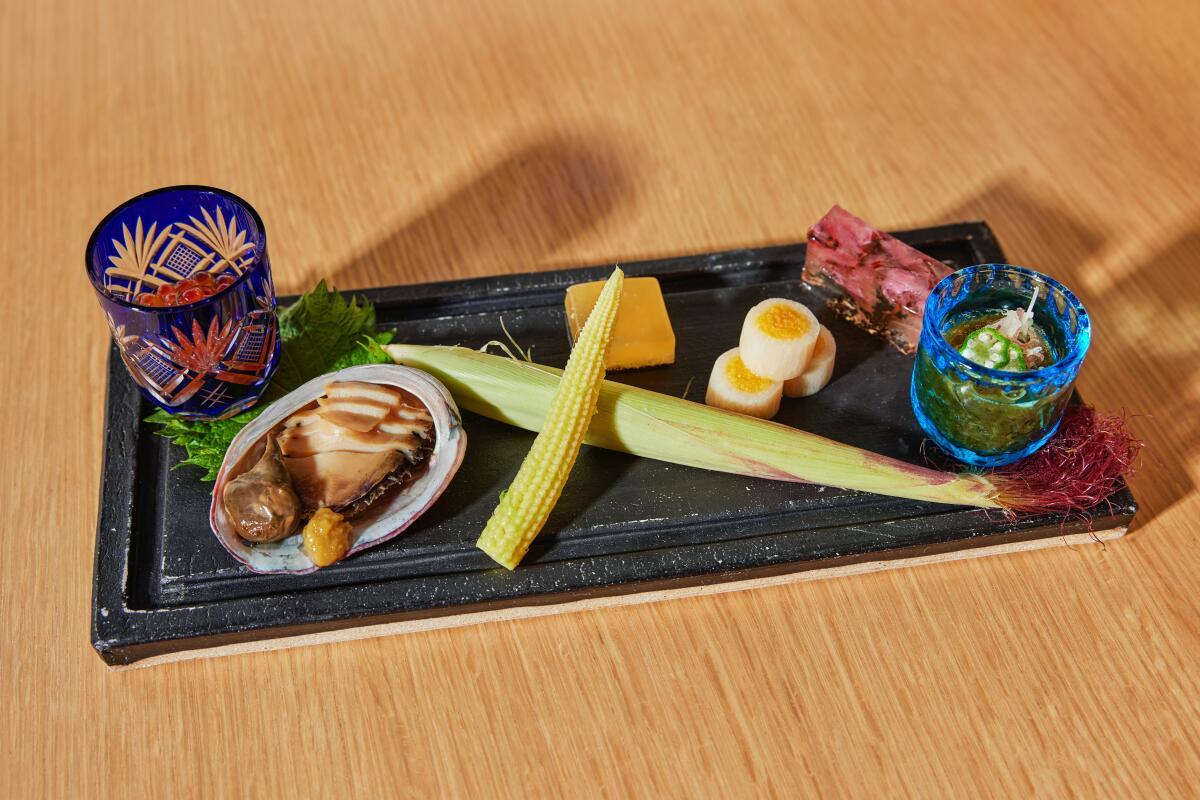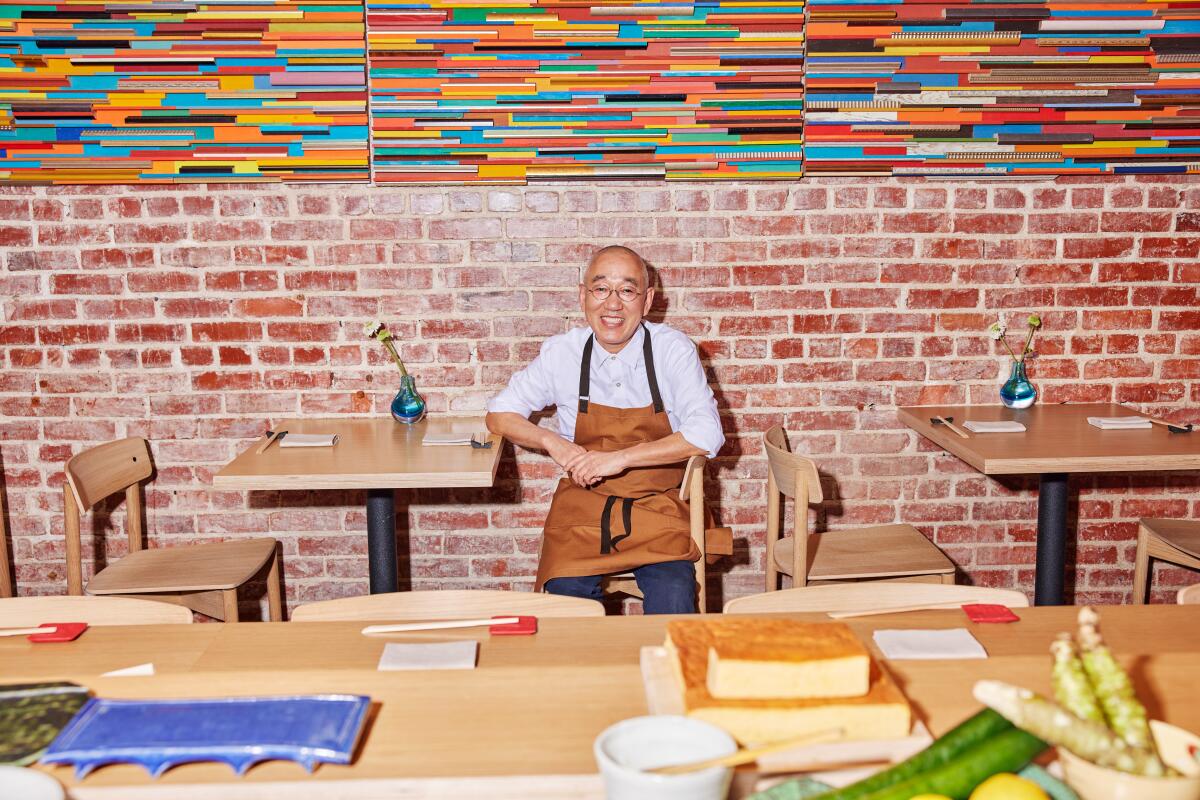Morihiro Onodera, sushi and the meaning of fine dining in L.A.
- Share via
Morihiro opened in Atwater Village during the final days of November. Then, as now, COVID-19 cases were spiking terrifyingly in Los Angeles. The city was days away from another stay-at-home order that would keep indoor dining shuttered for months.
During the restaurant’s first months, owner Morihiro “Mori” Onodera carried his business the way many high-end sushi bars were doing: He made exquisite takeout bentos full of tiny, detailed dishes and he blanketed boxes with rice and seafood for chirashi.
Enjoying this newsletter? Consider subscribing to the Los Angeles Times.
Your support helps us deliver the news that matters most. Become a subscriber.
Onodera is an L.A. sushi legend. He’s been accruing a fan base since he arrived in 1985, but many devotees came to know him at his first restaurant, Mori in West L.A., which operated from 2000 to 2011. No surprise, then, that carryout orders at Morihiro were brisk immediately, sometimes selling out by noon as Onodera and his team found their rhythm and footing.
Night seemed to fall oppressively early this past fall and winter. GPS map directions were off at first, sending customers to the alley that runs behind the building, and I startled manager Tokiko Binkley one evening by coming through the restaurant’s back door. I backed out, apologizing, and rushed around to grab my food at the entrance on Glendale Boulevard where the staff had placed a pickup table in the doorway.
Fast-forward to late last month, when I’m sitting at the six-seat sushi bar facing Onodera. That meal is the main focus of this week’s review, and I slip in mentions of some of my other favorite sushi greats in the city as well.
Eat your way across L.A.
Get our weekly Tasting Notes newsletter for reviews, news and more.
You may occasionally receive promotional content from the Los Angeles Times.
Thinking about sushi as a vital part of L.A.’s dining ecology led me down some rabbit holes, reading reviews of Onodera and related restaurants from previous generations of Times dining critics. Of course they all wrote beautifully.
Here’s Ruth Reichl reviewing Katsu, considered one of the city’s seminal top-flight sushi bars (and later an employer of Morihiro), in 1985:
“This is food to savor, to eat slowly. Meanwhile, Katsu took out a plump, shiny fish, a whole yellowtail, and began deliberately carving the fillets. He lovingly took down some long white platters that looked as if waves were rippling across them, and began arranging little tangles of shredded daikon, and piles of ruffly light green seaweed across the top. He was working deliberately as he grated a slender root of wasabi, the color of pistachios, into a paste to pile upon the platter. Fresh wasabi is not as hot as the powdered kind, but it is far more flavorful; the Japanese call this flavor namida, [or] tears.”

S. Irene Virbila wrote about Onodera several times during the Mori years. In this 2004 review she focuses on the restaurant’s omakase and bumps up the rating from 2 ½ to 3 out of 4 stars (y’all remember stars, right?):
“At the unprepossessing Mori Sushi in West Los Angeles, the waiter sets down a broad oval plate stippled in the browns and golds of autumn leaves, its texture rough as burlap. On it are four rows of nigiri-zushi, four pieces each, one for each of us. The composition is as flawless as an Agnes Martin painting. My architect friend is looking at the fish as if he has never seen sushi before. And in a sense he hasn’t, not this kind of quality. It’s evident even before you taste it — in the pearlescent pink and white gleam of halibut fin, cross-hatched with the knife; in the subtle marbling of wild yellowtail belly, my new sushi passion; in the silvery blue pinstripe running down a sliver of half beak, or Japanese silver fish; and in the alabaster translucence of Japanese squid.”
Jonathan Gold, who would have celebrated his 61st birthday this week, wrote about Onodera in 2018 after he started a tenure behind the counter at Shiki in Beverly Hills:
“Mostly there is Onodera, and after the first piece he nestles onto your serving plate, a slash of Japanese sea bream on a narrow pillar of body-temperature rice, you understand: softness not quite collapsing into richness, a breath of acid, a lick of salt from the kelp in which it has been marinated, a fine, searing filament of heat that vanishes as quickly as it appears — this is what sushi devotees are looking for when they save up their nickels, a definitive experience that exists only for the brief lifetime of a sigh. Is there the barest hint of smoke? It is difficult to tell. ...
“There is a slice from a Hokkaido octopus tentacle, girthy as an oak tree, with the kind of striations of texture you may associate with rare prime rib; wasabi-zapped Spanish mackerel; and madai, a kind of sea bream, briefly charred over a fire before it is made into sushi. Some nights Onodera finishes with the kind of zillion-layered omelet that makes you fear for the sanity of a chef with the patience to prepare it; sometimes with a simple, Tokyo-style roll stuffed with only rice and braised squash, a dish stunning in its simplicity and deftness of execution.
“Could a vegan sushi roll serve as a mic drop? In this case, definitively so.”
If you have the chance to eat Onodera’s kanpyo-maki at Morihiro, it remains a mic drop.

Have a question?
Other stories
Jenn Harris provides a rich and satisfying answer to this nuanced question: What is cacio e pepe and how did it take over the world?
Jean Trinh writes about Nellie and Chris Tran and their plans for Blossom Market Hall, a new food hall aiming to create community in the historic San Gabriel Mission District. It will house 13 vendors serving varied cuisines, including Vietnamese, Korean and Mexican options and Yonette Alleyne’s Caribbean Gourmet.
Jean also writes about Lasita in Far East Plaza reopening after a renovation, among other openings, in her final NewsFeed column. Thank you for the great work week after week, Jean!
And a big welcome to Stephanie Breijo, our new Food reporter! She joins us full-time after freelancing for the section over much of the first half of 2021. She’ll be taking over NewsFeed (and much more). If you have leads on restaurant openings, closings or other dining-related news, email her at stephanie.breijo@latimes.com.

Eat your way across L.A.
Get our weekly Tasting Notes newsletter for reviews, news and more.
You may occasionally receive promotional content from the Los Angeles Times.




